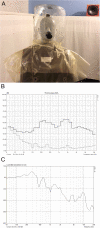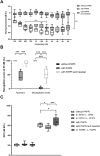Powered air-purifying respirators used during the SARS-CoV-2 pandemic significantly reduce speech perception
- PMID: 34592994
- PMCID: PMC8481762
- DOI: 10.1186/s12995-021-00334-y
Powered air-purifying respirators used during the SARS-CoV-2 pandemic significantly reduce speech perception
Abstract
Background: Due to the coronavirus disease 2019 (COVID-19) pandemic, interventions in the upper airways are considered high-risk procedures for otolaryngologists and their colleagues. The purpose of this study was to evaluate limitations in hearing and communication when using a powered air-purifying respirator (PAPR) system to protect against severe acute respiratory syndrome coronavirus type 2 (SARS-CoV-2) transmission and to assess the benefit of a headset.
Methods: Acoustic properties of the PAPR system were measured using a head and torso simulator. Audiological tests (tone audiometry, Freiburg speech test, Oldenburg sentence test (OLSA)) were performed in normal-hearing subjects (n = 10) to assess hearing with PAPR. The audiological test setup also included simulation of conditions in which the target speaker used either a PAPR, a filtering face piece (FFP) 3 respirator, or a surgical face mask.
Results: Audiological measurements revealed that sound insulation by the PAPR headtop and noise, generated by the blower-assisted respiratory protection system, resulted in significantly deteriorated hearing thresholds (4.0 ± 7.2 dB hearing level (HL) vs. 49.2 ± 11.0 dB HL, p < 0.001) and speech recognition scores in quiet (100.0 ± 0.0% vs. 2.5 ± 4.2%, p < 0.001; OLSA: 20.8 ± 1.8 dB vs. 61.0 ± 3.3 dB SPL, p < 0.001) when compared to hearing without PAPR. Hearing with PAPR was significantly improved when the subjects were equipped with an in-ear headset (p < 0.001). Sound attenuation by FFP3 respirators and surgical face masks had no clinically relevant impact on speech perception.
Conclusions: The PAPR system evaluated here can be considered for high-risk procedures in SARS-CoV-2-positive patients, provided that hearing and communication of the surgical team are optimized by the additional use of a headset.
Keywords: COVID-19; FFP3 respirator; PAPR; Personal protective equipment; Powered air-purifying respirator; SARS-CoV-2.
© 2021. The Author(s).
Conflict of interest statement
The authors declare that they have no competing interests.
Figures



Similar articles
-
Association of In-Ear Device Use With Communication Quality Among Individuals Wearing Personal Protective Equipment in a Simulated Operating Room.JAMA Netw Open. 2021 Apr 1;4(4):e216857. doi: 10.1001/jamanetworkopen.2021.6857. JAMA Netw Open. 2021. PMID: 33871614 Free PMC article.
-
Impact of Powered Air-Purifying Respirator Devices on Word Recognition in Health Care Providers.Otolaryngol Head Neck Surg. 2022 Sep;167(3):469-471. doi: 10.1177/01945998211058350. Epub 2021 Nov 9. Otolaryngol Head Neck Surg. 2022. PMID: 34752161
-
Powered Air Purifying Respirator (PAPR) restores the N95 face mask induced cerebral hemodynamic alterations among Healthcare Workers during COVID-19 Outbreak.J Neurol Sci. 2020 Oct 15;417:117078. doi: 10.1016/j.jns.2020.117078. Epub 2020 Aug 3. J Neurol Sci. 2020. PMID: 32768718 Free PMC article.
-
Use of powered air-purifying respirator (PAPR) by healthcare workers for preventing highly infectious viral diseases-a systematic review of evidence.Syst Rev. 2020 Aug 8;9(1):173. doi: 10.1186/s13643-020-01431-5. Syst Rev. 2020. PMID: 32771035 Free PMC article.
-
Use of powered air-purifying respirator(PAPR) as part of protective equipment against SARS-CoV-2-a narrative review and critical appraisal of evidence.Am J Infect Control. 2021 Apr;49(4):492-499. doi: 10.1016/j.ajic.2020.11.009. Epub 2020 Nov 10. Am J Infect Control. 2021. PMID: 33186678 Free PMC article. Review.
Cited by
-
Effects on communication due to face mask use: an integrative review.Rev Bras Enferm. 2023 Oct 9;76(4):e20220674. doi: 10.1590/0034-7167-2022-0674. eCollection 2023. Rev Bras Enferm. 2023. PMID: 37820148 Free PMC article. Review.
-
A Review of Filtration Performance of Protective Masks.Int J Environ Res Public Health. 2023 Jan 28;20(3):2346. doi: 10.3390/ijerph20032346. Int J Environ Res Public Health. 2023. PMID: 36767714 Free PMC article.
References
-
- Zhu N, Zhang D, Wang W, Li X, Yang B, Song J, Zhao X, Huang B, Shi W, Lu R, Niu P, Zhan F, Ma X, Wang D, Xu W, Wu G, Gao GF, Tan W, China Novel Coronavirus Investigating and Research Team A novel coronavirus from patients with pneumonia in China, 2019. N Engl J Med. 2020;382(8):727–733. doi: 10.1056/NEJMoa2001017. - DOI - PMC - PubMed
-
- Huang C, Wang Y, Li X, Ren L, Zhao J, Hu Y, Zhang L, Fan G, Xu J, Gu X, Cheng Z, Yu T, Xia J, Wei Y, Wu W, Xie X, Yin W, Li H, Liu M, Xiao Y, Gao H, Guo L, Xie J, Wang G, Jiang R, Gao Z, Jin Q, Wang J, Cao B. Clinical features of patients infected with 2019 novel coronavirus in Wuhan, China. Lancet. 2020;395(10223):497–506. doi: 10.1016/S0140-6736(20)30183-5. - DOI - PMC - PubMed
-
- World Health Organization . Coronavirus disease 2019 (COVID-19) Situation Report - 73. 2020.
LinkOut - more resources
Full Text Sources
Miscellaneous

